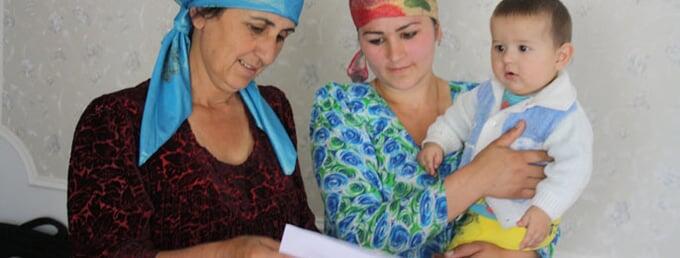KHOVALING, Tajikistan --- “Things were different in my day,” says 70-year-old Tojigul Qurbonova, a mother of ten. “Mothers with a lot of children were showered with benefits and had a good life,” she adds, showing off a ‘Mother Hero’ certificate she was awarded in 1980.
In those days, under the Soviet Union, big families were encouraged and supported. Mothers with more than five children were awarded gold medals, apartments, telephones, and received financial help in the form of child benefits, fully paid extended maternity leave and early retirement.
“It was fully deserved,” says Tojigul. “Having so many children takes up all your energy, and you age early.” Tojigul, who has 31 grandchildren and is now familiar with modern family planning methods, wants to protect her daughters and kelins (daughters-in-law) from hardships caused by having a large family, and regularly brings them to the reproductive health centre in Khovaling for free consultations and contraceptives.
This year's State of World Population discusses the human right to family planning.
Exercising the right to plan one’s family – with some help from the in-laws
In some areas of Tajikistan, tradition dictates that the kelin—or kelins, as polygamy is still not uncommon—lives with her husband and the in-laws. The mother-in-law takes major decisions in the household, including those related to the number and spacing of her grandchildren.
But reproductive health centres, established under the auspices of the Ministry of Health and supported by UNFPA, offer women modern contraceptives: pills, injectables and condoms. These are available to the local population for free.
“Women start using contraception for various reasons—in most cases it’s their economic situation, or they want a break between babies. It shows that the women, even in this remote region, are aware of birth control methods and the services we provide, and keen to exercise their human right to plan the family—with the approval of their mothers-in-law and husbands.”
As times change, so does family size
The right to family planning is explicitly mentioned in only one human rights treaty, the Convention on the Elimination of All Forms of Discrimination Against Women, which was adopted in 1979, when Bibinisso Sharipova, a 55-year-old mother of eight, had her first child.
“We didn’t know a thing about family planning. Contraceptives were not available and everybody had a big family,” she says. “Things are definitely easier now, and although I’m done having children, I want to make sure that the next generation—my daughters and kelins—really benefit from the modern birth control methods that are available in our town.”
According to official statistics, about one of four women in Tajikistan uses modern contraception. “However, the unmet need for family planning still exists, meaning that over 200,000 women do not have a proper access to family planning services or do not use contraception,” says Khurshed Irgitov, Project Associate at the UNFPA office in Dushanbe.
Weighing the economic and health consequences of larger families
Poverty also influences family size in Tajikistan, which is still recovering from conflict in the 1990s and where more than half the population lives below the national poverty line. These days smaller families are more common. On average, women give birth to 3.2 children.
“In the Soviet times raising a big family, at least from the economic point of view, was not an issue, but now you struggle even with two or three children,” says Saidnuriddin Zukhurov, head doctor at the Health Centre in the village of Voseh. “Most mothers cannot afford good food for themselves and their children, and suffer from anaemia and other conditions related to poor diet. An unhealthy mother is likely to have an unhealthy baby. These days people simply cannot afford to support big families.”
Education and levels of awareness also influence family size. “Having a lot of children, often one after another… reflects the level of education in our society,” says Guljakhon Bobosadikova, head of the non-governmental organization Women with Higher Education. “We should spend more time educating young parents—especially young fathers.”
A number of education and outreach programmes are already underway in the country and are helping increase demand for family planning. “At the heart of our activities…is the improved access of vulnerable populations to comprehensive and quality reproductive health services and information, especially in the rural areas,”says Nargis Rakhimova, National Programme Officer on Reproductive Health of UNFPA.
Back at her place, Khovaling’s Mother Hero can now sit back and count her blessings: “I look back on a well-lived life, and I want the best for my children and grandchildren. I want them to be responsible—and using contraception is a part of it.”
-- reported by Natasha Warcholak and Parviz Boboev


